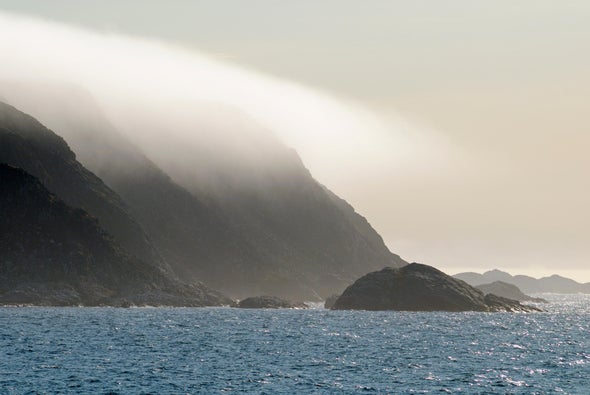CLIMATEWIRE | Arctic sea ice is rapidly vanishing as the world warms, opening up potential new shipping routes across the top of the world. But there’s a catch: Less ice means more fog, making it harder and more dangerous for ships to navigate the thawing sea.
It’s an overlooked climate trade-off, according to a new study. And while new Arctic passages often are touted as faster alternatives to conventional shipping routes through the Panama and Suez canals, foggy conditions can cause delays.
Fog in the Northwest Passage, which snakes through the Canadian Archipelago, could slow projected shipping times by as much as three days in the coming years, the study suggests. And it could increase the odds of collisions with icebergs floating in the water.
It’s a hazard that decisionmakers should take into account when designing new shipping routes, the researchers suggest. Shifting away from the foggiest areas could save a little time and reduce the risk of accidents.
“The future of shipping in the Arctic is unclear, but fog could pose a significant challenge,” said Xianyao Chen, a physical oceanographer at the Ocean University of China and a co-author of the study, in a statement. “When designing shipping routes across the Arctic, we need to consider the impact of fog.”
The study outlines a simple natural phenomenon. When sea ice melts, the surface of the ocean is exposed to the atmosphere. The air and the water exchange heat and moisture, and fog appears in the air.
The fog is often heaviest in areas where patches of open water have newly formed, close to the edge of the ice. And as Arctic sea ice continues to melt away, fog is likely to increase over the new stretches of open ocean.
The researchers used historic data on Arctic fog conditions, combined with model simulations, to investigate how these conditions might affect shipping routes in the future. They examined both the Northwest Passage and the Northern Sea Route, which cuts along the Russian coastline. Both passages are becoming increasingly navigable as more ice melts away, opening up possibilities for expanded trade routes.
But the research finds that fog likely has already slowed sailing times through both the Northwest Passage and the Northern Sea Route. And it will cause further delays in the coming decades.
Under a moderate future climate scenario, in which the world warms by as much as 3 degrees Celsius by the end of the century, the study finds that fog could lengthen shipping times through the Northwest Passage by more than 25 percent, or around an extra three days. That’s close to the amount of warming scientists expect by the end of the century unless humanity swiftly increase its efforts to reduce global greenhouse gas emissions.
The effect is less severe in the Northern Sea Route, where delays are likely to average less than a day.
That means many of the current projections for Arctic shipping routes, which generally don’t account for an increase in fog, “may be too optimistic” in terms of the amount of time and money they can save, the study suggests.
Currently, most designs for Arctic shipping routes have vessels sticking close to the edge of the ice as they wend their way through the sea. The study suggests that these are likely to be some of the foggiest places, and that ships could lower their risks and save time — perhaps as much as a day — by detouring a bit farther out of the way.
At the same time, shipping considerations are just one side effect of Arctic climate change. The Arctic is among the most rapidly warming regions of the planet, with temperatures rising at around three times the global average, and it’s already facing a vast array of consequences.
As the ice disappears, the region’s delicate marine ecosystem is changing. Many organisms depend on Arctic sea ice, including polar bears, who use the ice as a hunting platform.
When sea ice melts away, it also allows the surface of the ocean to absorb more heat from the atmosphere, increasing the speed of Arctic warming overall. And research suggests that rapid Arctic warming may be altering the atmosphere in ways that affect weather patterns in other parts of the world, including places such as Europe and North America.
Currently, much of the Arctic Ocean remains frozen for the entire year. But with sea ice dwindling, scientists have warned the Arctic is likely to begin experiencing ice-free summers within a few decades — and potentially as soon as the 2030s.
Reprinted from E&E News with permission from POLITICO, LLC. Copyright 2023. E&E News provides essential news for energy and environment professionals.


